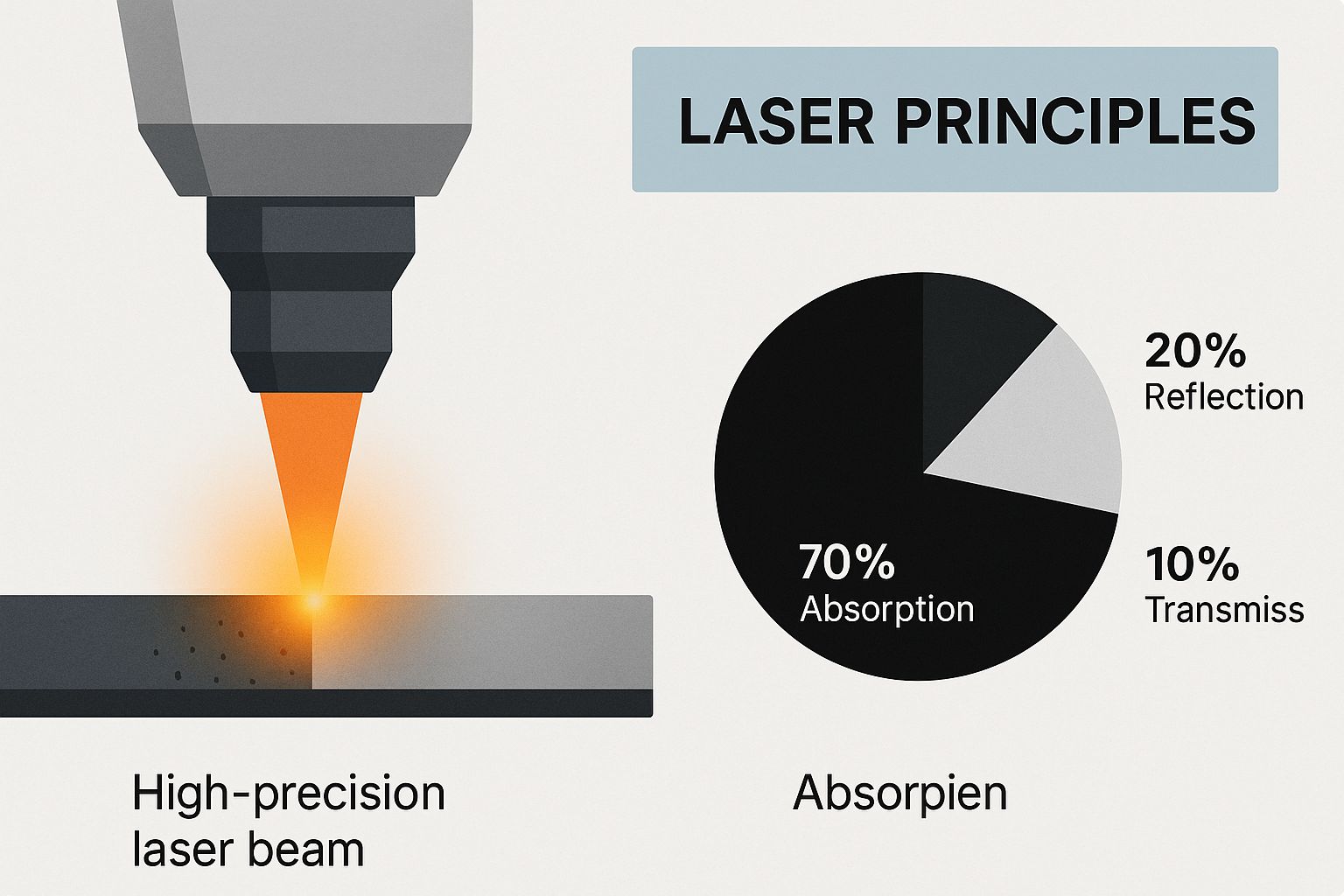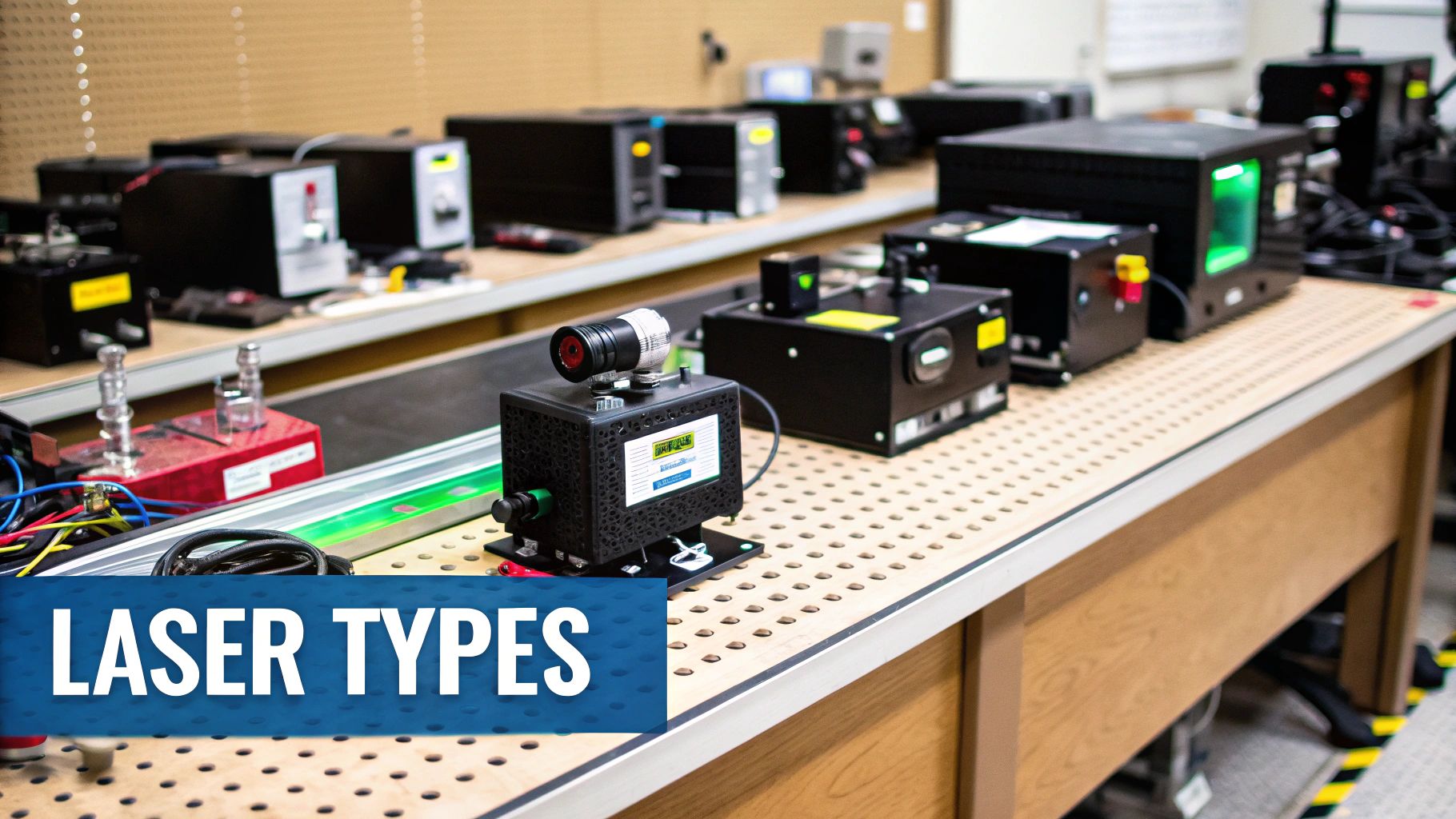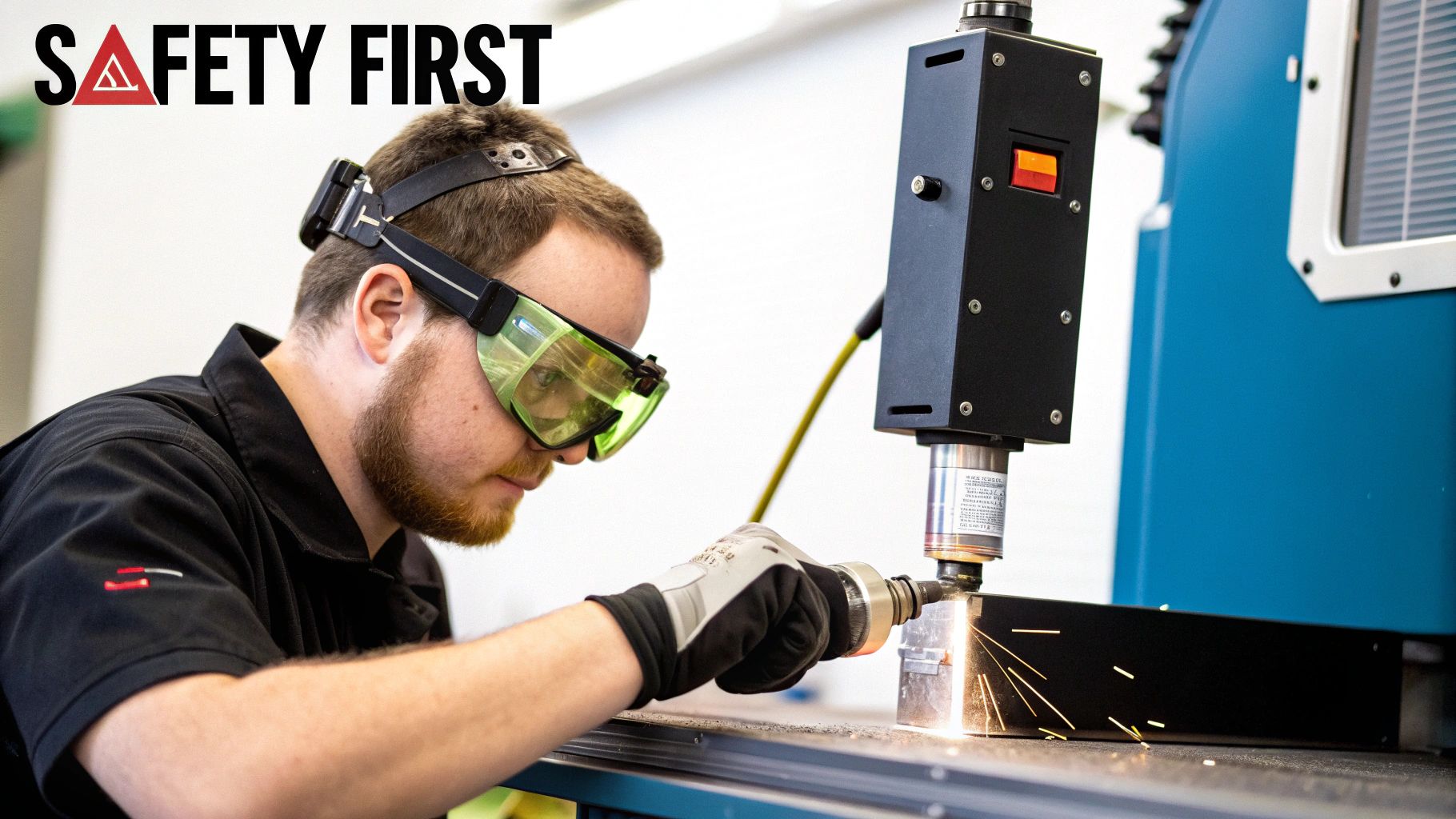How Does Laser Cleaning Work? Discover the Key Facts
- Laserverse
- May 9
- 10 min read
The Science Behind Laser Cleaning: Breaking Down the Physics
Laser cleaning is a precise and effective cleaning method that harnesses the power of light. But how does it actually work? The process involves directing a highly concentrated beam of light, generated by a laser, onto a contaminated surface. This interaction between light and matter is what makes laser cleaning so effective.
Photomechanical, Photothermal, and Photochemical Processes
The interaction of the laser with the surface triggers several key processes: photomechanical, photothermal, and photochemical reactions. The photomechanical process causes the contaminant to detach from the surface through rapid expansion and contraction caused by the laser's energy. Imagine it as a microscopic explosion dislodging the dirt.
The photothermal process uses heat generated by the laser to vaporize or melt the contaminant. This is especially effective for removing organic materials and rust. For example, a laser can precisely vaporize a thin layer of rust without harming the underlying metal.
Finally, the photochemical process breaks down the contaminant's chemical bonds, transforming it into a gas that dissipates into the air. This is particularly useful for removing tough stains or coatings.
Different Laser Types for Different Cleaning Effects
Different types of lasers, including fiber lasers, solid-state lasers, and pulsed lasers, each play a unique role in laser cleaning. Fiber lasers are known for their efficiency and compact size, making them adaptable for a wide range of cleaning applications. Solid-state lasers offer high power and precision, while pulsed lasers deliver short, intense bursts of energy, making them well-suited for delicate materials. Selecting the right laser type is essential for achieving optimal cleaning results without damaging the surface.
Laser cleaning has become increasingly popular, particularly in North America. In Canada, it's highly valued for its efficiency and environmental benefits. Laser cleaning systems are now frequently employed in restoration projects to clean architectural surfaces like sandstone, marble, and granite without causing damage. This gentler approach is preferred for delicate surfaces where traditional methods like micro-abrasive cleaning or chemical cleaning could be harmful. The global laser cleaning market has experienced substantial growth in recent years due to its precision and efficiency compared to traditional cleaning methods. Learn more about the laser cleaning market. This growth reflects the broader North American trend of adopting laser technology for precision surface cleaning applications.
Inside Modern Laser Cleaning Systems: From Source to Surface
Modern laser cleaning systems offer a precise and controlled approach to cleaning, surpassing traditional methods in accuracy and effectiveness. These systems harness the power of lasers to meticulously remove contaminants, opening up new possibilities in various industries. This section delves into the inner workings of these systems, tracing the journey of the laser from its source to the targeted surface.
Key Components and Their Functions
To understand the intricacies of laser cleaning, it's essential to first grasp the roles of the core components within these systems. Each element contributes to the overall precision and efficiency of the cleaning process.
Let's take a look at the following table which outlines the key components:
Key Components of Laser Cleaning Systems
Component | Function | Typical Specifications |
|---|---|---|
Laser Source | Generates the concentrated beam of light. Common types include fiber lasers and pulsed lasers. | Fiber lasers: Wavelengths around 1064 nm, power ranging from hundreds of watts to kilowatts. Pulsed lasers: Nanosecond to femtosecond pulse durations, variable wavelengths. |
Delivery Optics | Guides and focuses the laser beam onto the target surface using specialized lenses and mirrors. | Lenses with specific focal lengths and coatings optimized for the laser wavelength; mirrors with high reflectivity. |
Control System | Software that manages laser parameters like pulse frequency, scan speed, and energy density, enabling precise control over the cleaning process. | Programmable logic controllers (PLCs), embedded systems, and dedicated software interfaces for parameter adjustments and automation. |
Safety Systems | Protects operators during high-power laser operations through enclosed beam paths and interlocks. | Class 4 laser safety enclosures, interlocks that prevent operation when the enclosure is open, and emergency stop buttons. |
This table summarizes the essential parts of a laser cleaning system and provides a general overview of their specifications. The specifics can vary depending on the system's intended application.
Visualizing Laser Principles in Action
The image below illustrates the laser cleaning process on a metal surface, demonstrating the focused action of the laser beam on the contaminant.

This visualization showcases the precision of laser cleaning, highlighting how the beam targets only the unwanted material, leaving the surrounding area unaffected.
Real-World Applications and Operator Expertise
Laser cleaning systems are finding increasing use across various sectors in Canada. The expertise of skilled operators is crucial for optimizing these systems. By adjusting parameters like pulse frequency, operators can tailor the cleaning process for diverse applications, from removing rust on heavy machinery to cleaning delicate historical artifacts. This adaptability highlights the versatility of laser cleaning. Modern control systems, often featuring automation, enhance both precision and efficiency, allowing for seamless integration into existing workflows. You can explore our available laser cleaning products here.
The Environmental Revolution: Why Laser Cleaning Leads the Way

Traditional cleaning methods often depend on harsh chemicals and abrasive materials. These methods create a substantial amount of waste, posing environmental concerns and health risks for workers. Laser cleaning, however, offers a significantly different and safer approach. It drastically reduces or even eliminates these hazards, making it a crucial development for minimizing environmental impact.
A Comparative Look at Environmental Impact
How does laser cleaning achieve such impressive environmental results? The key is its precise, non-contact nature. It uses light to remove contaminants, eliminating the need for secondary materials like abrasive media or chemical solvents. This precision leads to a considerable reduction in waste. Furthermore, laser cleaning typically requires less energy and water than traditional methods, minimizing its overall environmental footprint.
To illustrate the differences, let's examine a comparison table showcasing various cleaning methods and their respective environmental impacts.
To better understand the environmental advantages of laser cleaning, the following table compares it to other common cleaning methods:
Cleaning Method | Waste Production | Chemical Usage | Water Consumption | Energy Efficiency |
|---|---|---|---|---|
Laser Cleaning | Minimal to None | None | Low | High |
Sandblasting | High (abrasive media) | May be used for pre-treatment | Moderate | Moderate |
Chemical Cleaning | Moderate (chemical waste) | High | Moderate to High | Low to Moderate |
Dry Ice Blasting | Low (dry ice sublimates) | None | Low | Moderate |
This comparison clearly demonstrates how laser cleaning stands out as a more environmentally friendly industrial cleaning method. The minimized waste, lack of chemicals, and efficient use of resources highlight its eco-conscious advantages.
The Business Case for Green Cleaning
The environmental benefits of laser cleaning translate into tangible business advantages. Reduced waste leads to lower disposal costs, directly impacting a company’s bottom line. Eliminating chemical handling also improves workplace safety and streamlines regulatory compliance. This is particularly important in regions with stringent environmental regulations, such as California.
Laser cleaning’s non-contact process minimizes noise and exposure to potentially hazardous materials. This makes it an especially appealing option for businesses operating in California. Industries like aerospace and electronics, which demand high-precision cleaning, stand to gain considerably from this technology. You can explore more about laser cleaning with IPG Photonics, a leading developer of laser solutions.
Sustainability and the Bottom Line
Forward-thinking companies are incorporating laser cleaning into their sustainability strategies. They understand that environmental responsibility and profitability are not mutually exclusive. By adopting this technology, businesses can reduce their environmental impact while improving operational efficiency. This contributes to both a healthier planet and a healthier bottom line. For a broader look at laser technology and its various uses, check out additional resources on laser applications.
Transforming Industries: Laser Cleaning Across Sectors
Laser cleaning is rapidly changing industrial surface preparation and maintenance. This technology offers a level of precision and control unavailable with traditional methods. From aerospace to art restoration, laser cleaning demonstrates value across a broad spectrum of sectors.
Aerospace: Ensuring Critical Cleanliness
In aerospace, even microscopic contaminants can compromise the performance and safety of critical components. Laser cleaning provides a highly effective solution, precisely removing particles, oxides, and other unwanted substances from sensitive surfaces without damaging the underlying material. This is vital for ensuring the longevity and reliability of aircraft parts.
Automotive: Perfecting Surface Preparation
Laser cleaning is gaining traction within the automotive sector, particularly in areas with a strong high-tech manufacturing presence like California. It's used to prepare surfaces for painting and bonding by removing oils, rust, and other contaminants. This ensures optimal adhesion of coatings and adhesives, leading to a higher quality finish and improved durability.
Electronics Manufacturing: Achieving Unprecedented Cleanliness
The electronics industry demands stringent cleanliness standards, and laser cleaning plays a key role. It's particularly effective for removing residues and contaminants from circuit boards and electronic components. This precision cleaning maintains product quality and reliability.
Heritage Conservation: Saving Irreplaceable Artifacts
Laser cleaning has revolutionized heritage conservation. Conservators use it to meticulously remove dirt, corrosion, and old varnish from delicate artifacts, revealing their original beauty without causing damage. This preserves priceless historical pieces. Laser cleaning offers an environmentally friendly alternative to traditional methods, much like the hydrogen fuel cell drone promotes sustainability in other fields.
Manufacturing: Boosting Production Line Efficiency
Laser cleaning is increasingly integrated into manufacturing, especially for cleaning molds, dies, and tooling. Quickly and effectively removing residues and contaminants reduces downtime and improves production efficiency. This translates to cost savings and increased productivity. One study found that laser cleaning reduced cleaning time by 50% compared to traditional sandblasting, significantly accelerating production.
Measuring the Impact of Laser Cleaning
The benefits of laser cleaning are demonstrable. Real-world implementations show measurable improvements. In automotive manufacturing, for example, laser cleaning has reduced paint defects by 20%. In heritage conservation, it has enabled the restoration of artifacts previously considered too fragile to clean.
A Versatile Technology With a Bright Future
The versatility of laser cleaning, combined with its precision and environmental advantages, makes it a vital technology. As more industries recognize its benefits, laser cleaning adoption will likely continue to expand, resulting in cleaner, more efficient, and more sustainable operations across diverse sectors.
Beyond Traditional Methods: Why Laser Cleaning Wins

Is laser cleaning truly superior to traditional methods, or is it simply overhyped? This section offers a data-driven comparison of laser cleaning with conventional methods such as sandblasting, chemical treatments, dry ice blasting, and manual cleaning. We'll examine the strengths of laser cleaning and identify situations where traditional methods might still be advantageous. Finally, we'll delve into the overall costs, encompassing initial investment, operational expenses, and maintenance.
Performance Metrics: Laser Cleaning vs. Traditional Methods
Laser cleaning offers exceptional precision, making it well-suited for intricate or fragile items. For instance, in the field of heritage conservation, lasers can meticulously clean delicate artifacts without causing damage, a task often impossible with abrasive techniques like sandblasting. Laser cleaning is increasingly utilized in certain inspection processes. Advanced drone inspection software can further enhance efficiency in these workflows. Furthermore, laser cleaning is a non-contact procedure, minimizing the risk of surface damage often associated with methods like sandblasting or manual scrubbing.
However, traditional methods may still be preferable in certain circumstances. Sandblasting, for example, can be a more economical choice for large-scale cleaning of heavily corroded metal. This raises the question of the total cost associated with laser cleaning. For more details, you might find our sitemap helpful.
The Complete Cost Equation: Beyond the Initial Investment
While the upfront cost of a laser cleaning system can be greater than that of traditional equipment, the long-term cost benefits often justify this initial investment. Laser cleaning eliminates the need for consumables such as abrasive media and chemicals, resulting in substantial cost savings over time. Furthermore, laser cleaning systems typically require less maintenance than traditional equipment, contributing to further long-term savings. One study revealed that businesses adopting laser cleaning achieved a 30% reduction in their annual cleaning costs.
When Does Laser Cleaning Make the Most Sense?
Laser cleaning is a compelling solution when precision, control, and minimal environmental impact are critical priorities. It is particularly well-suited for industries like aerospace, where cleaning vital components without causing damage is essential. Additionally, in industries subject to strict environmental regulations, such as those in CA, the minimal waste generated by laser cleaning presents significant advantages.
A Table of Comparison: Cleaning Method Effectiveness
Feature | Laser Cleaning | Sandblasting | Chemical Cleaning | Dry Ice Blasting | Manual Cleaning |
|---|---|---|---|---|---|
Precision | High | Low | Moderate | Moderate | Low |
Surface Damage | Low | High | Moderate | Low | Moderate |
Environmental Impact | Low | Moderate | High | Low | Moderate |
Speed | High | Moderate | Moderate | Moderate | Low |
Cost (Initial) | High | Low | Low | Moderate | Low |
Cost (Long-Term) | Low | Moderate | High | Moderate | Moderate |
This table summarizes the key distinctions between these cleaning methods, enabling a quick comparison based on specific project needs. Laser cleaning frequently offers the optimal balance of precision, environmental responsibility, and long-term cost-effectiveness.
Finding Your Perfect Match: Selecting a Laser Cleaning System
Choosing the right laser cleaning system is a critical step towards achieving optimal results and maximizing your return on investment. This guide will walk you through the key considerations for selecting a system that perfectly aligns with your specific needs.
Assessing Your Cleaning Needs
Before diving into technical specifications, it's essential to clearly define your cleaning requirements. Ask yourself key questions: What materials will you be working with? What types of contaminants need removing? What are the size and complexity of the parts you'll be cleaning? These questions help define the scope of your cleaning operations. Remember, cleaning delicate electronic components requires a different approach than removing rust from heavy machinery.
Laser Power and Wavelength: Matching the Right Tool to the Job
Laser power, measured in watts (W), influences the speed and effectiveness of cleaning. Higher power systems can tackle tougher contaminants and larger surface areas more quickly. Wavelength, usually measured in nanometers (nm), affects how the laser interacts with specific materials. Certain wavelengths are better absorbed by particular contaminants, optimizing cleaning performance.
Mobility and Accessibility: Where Will You Be Cleaning?
Consider the system's portability. Portable systems offer flexibility for on-site cleaning, ideal for large or immobile parts. Stationary systems are better suited for high-volume cleaning in a controlled environment. Think about the accessibility of the areas you need to clean. This determines whether a handheld, robotic arm-mounted, or custom-integrated system is the best fit.
Automation and Control Features: Enhancing Precision and Efficiency
Modern laser cleaning systems offer a range of automation and control options. Programmable settings allow precise control over laser parameters, such as pulse frequency and scan speed. Automated scanning systems enhance efficiency, especially for repetitive tasks. These automated features increase productivity and improve cleaning consistency.
Material Compatibility: Ensuring Safe and Effective Cleaning
Not all lasers are suitable for all materials. Some materials absorb laser energy differently, and improper selection can cause damage. Ensuring the chosen system is compatible with your materials is crucial. Cleaning delicate historical artifacts requires a less powerful laser than cleaning industrial machinery.
Calculating Your ROI: Measuring the True Value of Laser Cleaning
Calculating the return on investment (ROI) involves considering multiple factors. Labor savings from increased cleaning speed are a significant benefit. The elimination of consumables, like abrasive media or chemicals, reduces costs further. Improvements in cleaning quality, such as reduced rework and increased product lifespan, contribute to the overall ROI. By quantifying these factors, you can accurately assess the value of transitioning to laser cleaning.
Implementation and Training: Getting Started With Laser Cleaning
Successful implementation involves proper operator training for safe and effective equipment use. Integrating the system into existing workflows may require adjustments to processes and infrastructure. Consider these factors during planning for a smooth transition. Adhering to safety protocols is paramount for protecting personnel and equipment during operations.
Ready to experience the precision and efficiency of laser cleaning? Explore Laserverse, Canada’s leading provider of advanced laser cleaning solutions. We offer a range of systems, from our compact Netalux Needle series for small to mid-sized components to the powerful Netalux Jango for large-scale cleaning. Discover the perfect laser cleaning system for your needs.

